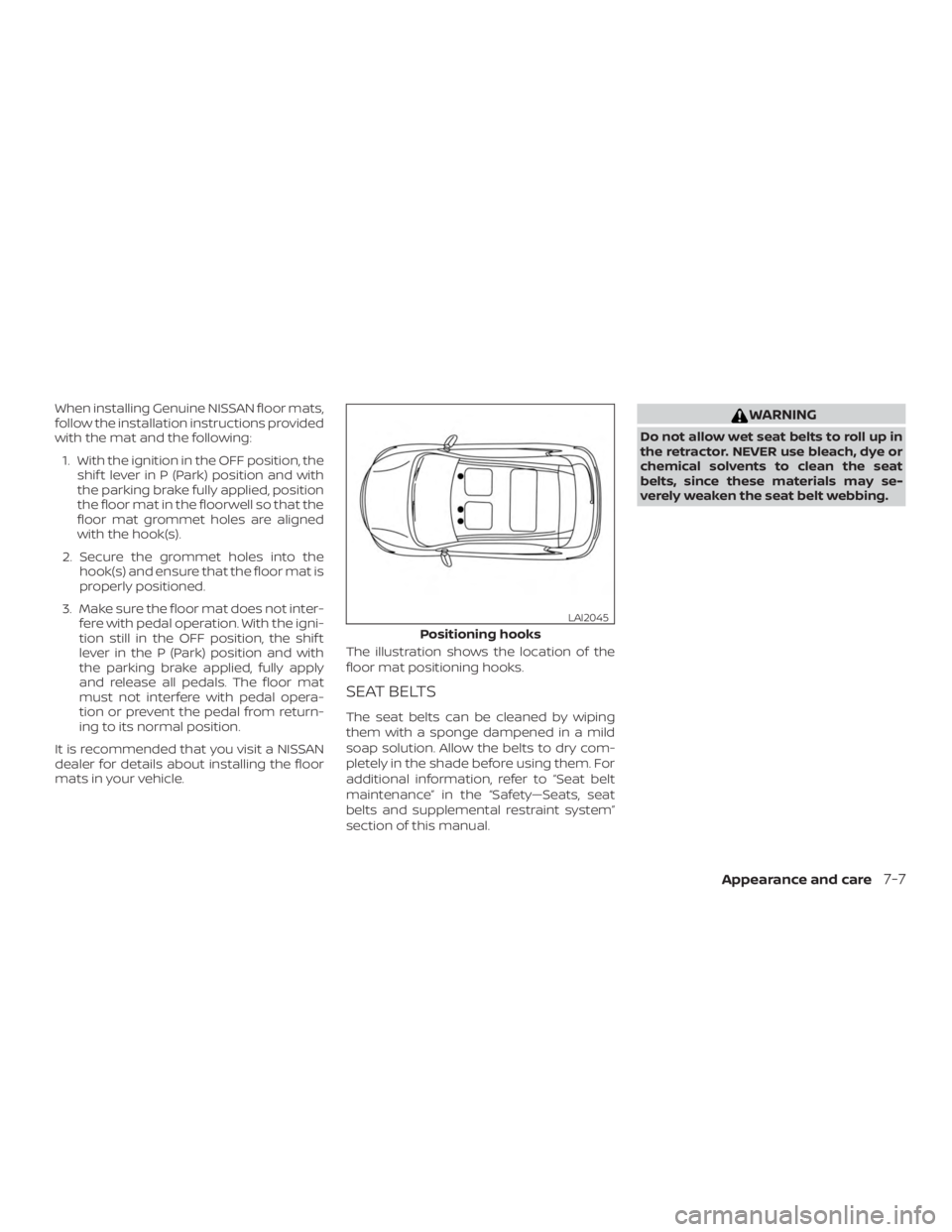Page 329 of 428
WARNING
Always follow the instructions below.
Failure to do so could result in damage
to the charging system and cause per-
sonal injury.1. If the booster battery is in another ve- hicle, position the two vehicles to bring
their batteries near each other.
Do not allow the two vehicles to
touch. 2. Apply the parking brake. Move the shif t
lever to P (Park). Switch off all unneces-
sary electrical systems (lights, heater,
air conditioner, etc.).
3. Ensure the vent caps are level and tight.
4. Connect the jumper cables in the se- quence illustrated (
�A,�B,�C,�D).
Page 341 of 428

When installing Genuine NISSAN floor mats,
follow the installation instructions provided
with the mat and the following:1. With the ignition in the OFF position, the shif t lever in P (Park) position and with
the parking brake fully applied, position
the floor mat in the floorwell so that the
floor mat grommet holes are aligned
with the hook(s).
2. Secure the grommet holes into the hook(s) and ensure that the floor mat is
properly positioned.
3. Make sure the floor mat does not inter- fere with pedal operation. With the igni-
tion still in the OFF position, the shif t
lever in the P (Park) position and with
the parking brake applied, fully apply
and release all pedals. The floor mat
must not interfere with pedal opera-
tion or prevent the pedal from return-
ing to its normal position.
It is recommended that you visit a NISSAN
dealer for details about installing the floor
mats in your vehicle. The illustration shows the location of the
floor mat positioning hooks.
SEAT BELTS
The seat belts can be cleaned by wiping
them with a sponge dampened in a mild
soap solution. Allow the belts to dry com-
pletely in the shade before using them. For
additional information, refer to “Seat belt
maintenance” in the “Safety—Seats, seat
belts and supplemental restraint system”
section of this manual.
Page 348 of 428
CHECKING ENGINE OIL LEVEL
1. Park the vehicle on a level surface andapply the parking brake.
2. Start the engine and let it idle until it reaches operating temperature.
3. Turn off the engine. Wait more than
10 minutes for the oil to drain back
into the oil pan.
4. Remove the dipstick and wipe it clean. Reinsert it all the way. 5. Remove the dipstick again and check
the oil level. It should be between the H
(High) and L (Low) marks�B. This is the
normal operating oil level range. If the
oil level is below the L (Low) mark
�A,
remove the oil filler cap and pour rec-
ommended oil through the opening.
Do not overfill
�C.
6. Recheck oil level with the dipstick.
It is normal to add some oil between oil
maintenance intervals or during the
break-in period, depending on the sever-
ity of operating conditions.
Page 421 of 428

NISSAN Vehicle Immobilizer
System...................2-41,5-14O
Octane rating (See fuel octane rating). . .10-5
Odometer ....................2-5
Oil Capacities and recommended
fuel/lubricants...............10-2
Changing engine oil ............8-7
Changing engine oil filter .........8-8
Checking engine oil level .........8-6
Engine oil ...................8-6
Engine oil and oil filter
recommendation ..........10-2,10-6
Engine oil viscosity .............10-6
Outsidemirrorcontrol............3-29
Outsidemirrors................3-29
Overhead sunglasses holder ........2-58
Overheat Ifyourvehicleoverheats.........6-10
Owner's manual order form ........10-20
Owner's manual/service manual order
information..................10-20
P
Parking Parking brake operation .........5-22
Parking/parkingonhills.........5-81
Parkingbrake..................5-22
Personal lights .................2-68 Power
Power door locks ..............3-5
Poweroutlet................2-54
Powerrearwindows ...........2-61
Powersteeringfluid............8-10
Power steering system .........5-82
Powerwindows..............2-60
Rearpowerwindows...........2-61
Poweroutlet..................2-54
Powersteering.................5-82
Powersteeringfluid..............8-10
Precautions Maintenance precautions .........8-2
Precautions on booster
seats............1-22, 1-28, 1-35, 1-39
Precautions on child
restraints.........1-22, 1-28, 1-35, 1-39
Precautions on seat belt usage .....1-11
Precautions on supplemental restraint
system ................... .1-43
Precautions when starting and
driving.....................5-4
Push starting ..................6-10
R
Radio Car phone or CB radio ..........4-33
Rain-sensing auto wiper system ......2-44
Readiness for inspection maintenance
(I/M) test ....................10-19
RearCrossTrafficAlert(RCTA)........5-33
Rear power sunshade ............2-65
Rearpowerwindows.............2-61
Rearseat.................... .1-5Rear sun shade
................2-65
RearViewMonitor................4-3
Rear window and outside mirror defroster
switch......................2-45
Recommended Fluids ............10-2
Recorders EventData.................10-19
Refrigerant recommendation .....10-2,10-7
Registering a vehicle in another
country .....................10-10
Remote Engine Start ..........3-18,5-15
Reporting safety defects (US only) . . . .10-18
S
Safety Child safety rear door lock ........3-6
Childseatbelts .....1-22, 1-28, 1-35, 1-39
Reporting safety defects (US only) . .10-18
Seat adjustment Front power seat adjustment .......1-3
Seatback pockets ...............2-56
Seat belt Childsafety................ .1-19
Infants and small children ........1-20
InjuredPerson............... .1-14
L
argerchildren.............. .1-20
Precautionsonseatbeltusage.....1-11
Pregnant women ..............1-14
Seat belt extenders ............1-18
Seat belt maintenance ..........1-18
Seatbelts................1-11, 7-7
Shoulder belt height adjustment . . . .1-18
Three-pointtypewithretractor.....1-14
Seat belt extenders ..............1-18
11-5